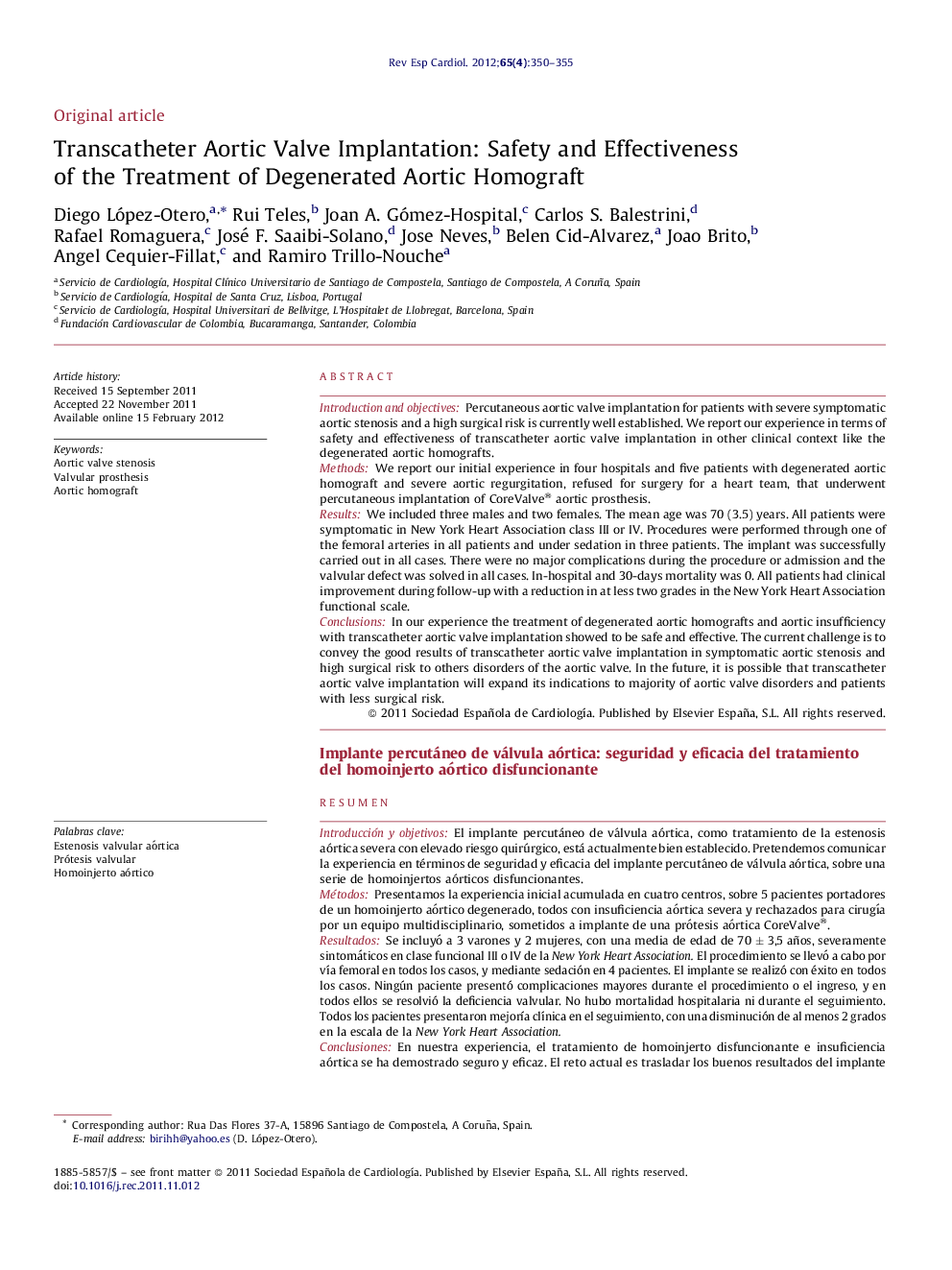| Article ID | Journal | Published Year | Pages | File Type |
|---|---|---|---|---|
| 3018114 | Revista Española de Cardiología (English Edition) | 2012 | 6 Pages |
Introduction and objectivesPercutaneous aortic valve implantation for patients with severe symptomatic aortic stenosis and a high surgical risk is currently well established. We report our experience in terms of safety and effectiveness of transcatheter aortic valve implantation in other clinical context like the degenerated aortic homografts.MethodsWe report our initial experience in four hospitals and five patients with degenerated aortic homograft and severe aortic regurgitation, refused for surgery for a heart team, that underwent percutaneous implantation of CoreValve® aortic prosthesis.ResultsWe included three males and two females. The mean age was 70 (3.5) years. All patients were symptomatic in New York Heart Association class III or IV. Procedures were performed through one of the femoral arteries in all patients and under sedation in three patients. The implant was successfully carried out in all cases. There were no major complications during the procedure or admission and the valvular defect was solved in all cases. In-hospital and 30-days mortality was 0. All patients had clinical improvement during follow-up with a reduction in at less two grades in the New York Heart Association functional scale.ConclusionsIn our experience the treatment of degenerated aortic homografts and aortic insufficiency with transcatheter aortic valve implantation showed to be safe and effective. The current challenge is to convey the good results of transcatheter aortic valve implantation in symptomatic aortic stenosis and high surgical risk to others disorders of the aortic valve. In the future, it is possible that transcatheter aortic valve implantation will expand its indications to majority of aortic valve disorders and patients with less surgical risk.
ResumenIntroducción y objetivosEl implante percutáneo de válvula aórtica, como tratamiento de la estenosis aórtica severa con elevado riesgo quirúrgico, está actualmente bien establecido. Pretendemos comunicar la experiencia en términos de seguridad y eficacia del implante percutáneo de válvula aórtica, sobre una serie de homoinjertos aórticos disfuncionantes.MétodosPresentamos la experiencia inicial acumulada en cuatro centros, sobre 5 pacientes portadores de un homoinjerto aórtico degenerado, todos con insuficiencia aórtica severa y rechazados para cirugía por un equipo multidisciplinario, sometidos a implante de una prótesis aórtica CoreValve®.ResultadosSe incluyó a 3 varones y 2 mujeres, con una media de edad de 70 ± 3,5 años, severamente sintomáticos en clase funcional III o IV de la New York Heart Association. El procedimiento se llevó a cabo por vía femoral en todos los casos, y mediante sedación en 4 pacientes. El implante se realizó con éxito en todos los casos. Ningún paciente presentó complicaciones mayores durante el procedimiento o el ingreso, y en todos ellos se resolvió la deficiencia valvular. No hubo mortalidad hospitalaria ni durante el seguimiento. Todos los pacientes presentaron mejoría clínica en el seguimiento, con una disminución de al menos 2 grados en la escala de la New York Heart Association.ConclusionesEn nuestra experiencia, el tratamiento de homoinjerto disfuncionante e insuficiencia aórtica se ha demostrado seguro y eficaz. El reto actual es trasladar los buenos resultados del implante percutáneo de válvula aórtica en la estenosis aórtica severa degenerativa del anciano a pacientes con alto riesgo quirúrgico y otras afecciones de la aorta. Es posible que en el futuro el implante percutáneo de válvula aórtica abarque cada vez mayor número de enfermedades aórticas y pacientes de menor riesgo quirúrgico.
